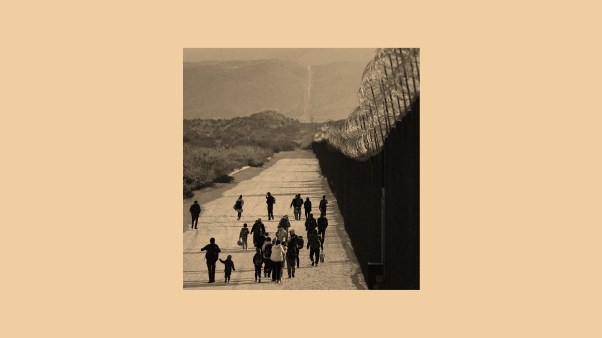Behind The Mike Warnke Exposé
Selling Satan: The Tragic History of Mike Warnke,by Mike Hertenstein and Jon Trott (Cornerstone Press, 475 pp.; $12.95, paper). Reviewed by Ken Sidey, former associate editor of CHRISTIANITY TODAY, currently managing editor of the Free Press in Greenfield, Iowa.
Ever since the Charlotte Observer “broke” the PTL story, members of the religious press—at least those who consider themselves journalists rather than public relations flacks—have asked, “Why wasn’t the story ours?” The question did not grow out of professional jealousy over a scandalous scoop. It came from a sense of community. Why was the exposure of such unethical behavior left to an “outside” source and not performed by a part of the evangelical body?
The editorial soul-searching that came of the PTL debacle found fertile ground in Cornerstone magazine, published by Jesus People USA in Chicago. Unfettered by the organizational and commercial ties that bind most other Christian publications (thanks to JPUSA’s austere communal lifestyle; see CT, Sept. 14, 1992, p. 20), the magazine has been able to devote extensive time, if only modest resources, to playing out its commitment to absolute truth. That course eventually sent it headfirst not only at Satanist-turned-Christian comedian Mike Warnke, but also at the whole evangelical celebrity/publishing/recording complex that built him.
The article “Selling Satan: The Tragic History of Mike Warnke” (Cornerstone, June 27, 1993) offered overwhelming evidence that exposed much of Warnke’s alleged Satanist background as fraudulent. It also documented that the entertainer was currently in his fourth marriage, and that his ministry, like Jim Bakker’s PTL, was spending huge amounts on luxury homes, antiques, and cars, as well as paying him a sizable salary.
To say the article, written by editors Mike Hertenstein and Jon Trott, sent shock waves through the evangelical subculture sounds like a cliché, but it is, in fact, an understatement. Beyond the Warnke story itself, the whole affair reheated debate over the same issues raised by PTL: Christian celebrity, biblical accountability, and the role—for good or bad—of mass media in contemporary Christian living.
Those issues are the ones best served by the book version of Selling Satan. Ostensibly, it is the lengthy account of the investigation that unraveled Warnke’s story. As such, its effect is not more powerful than the 20,000-word article. What the book does add is a closer look at the writers’ methods and motives. And that is indeed an important addition, because much of Warnke’s, and his defenders’, response has questioned those elements of Hertenstein and Trott’s work rather than answered the factual questions it raised.
Selling Satan actually contains several stories. It is a heavily footnoted examination of Warnke’s alleged past and his present as Christian celebrity and ministry leader; it is a look at other questionable stories of Satanic activity, such as those told by Lauren Stratford (the subject of an earlier Cornerstone exposé); it is a postscript to the Cornerstone article, noting the reactions, recriminations, and subsequent coverage; and it is a running commentary on the evangelical subculture. The book even includes an account of the coauthors’ evening interview with the infamous Anton LeVey, author of The Satanic Bible.
Only the most determined reader, or fellow journalist, is likely to stay with the detailed, step-by-step re-creation of Trott and Hertenstein’s trail. There are some points of suspense, though, as the writers track down Warnke’s former friends and classmates in San Bernardino, California, who were present during the crucial period when Warnke claimed to have become a Satanic high priest; or when the pair search for ministry tax records under the unfriendly gaze of a Southern sheriff right out of central casting.
But the story is handled less for drama than for validation of the information and the intentions of the journalists who gathered it. To that end, the book makes clear several points:
The thoroughness of the investigation. Hertenstein and Trott’s commitment to work only with firsthand sources and documents built an overwhelming case against Warnke. This is, simply, an example of journalism done right.
The desire to handle in biblical fashion a decidedly nonbiblical situation. At the same time the pair of reporters were uncovering their story, they were agonizing over the Christian ethics involved. Their own description of this issue is too brief. But an afterword on “Exposing Sin in the Church,” by anticult researchers Bob and Gretchen Passantino, who assisted and advised Trott and Hertenstein with the Warnke article, presents an effective apologetic for the use of investigative journalism in dealing with the failures of unrepentant, media-driven Christian leaders. It deserves wide reading.
Those elements work together to provide readers a lesson about truth—its nature, its value, and its pursuit—in the evangelical subculture. Does it really matter that Warnke’s testimony was false, given all the people he ministered to in the past 20 years? The answer should be obvious. The fact that it apparently was not—to so many for so long—shows why truth telling, such as the kind performed by Hertenstein and Trott, is so rare, and so needed.
Rumors From Hell
Satanic Panic,by Jeffrey S. Victor (Open Court, 398 pp.; $16.95, paper; $38.95, hardcover). Reviewed by Susan Bergman, the author of Anonymity: The Secret Life of an American Family (Farrar, Strauss, Giroux).
In the summer of 1992, a megachurch in the Chicago area “disfellowshipped” one of its members for unsubstantiated claims that he was a Satanic cult leader who had ritually abused a woman. The woman’s identity was not revealed by the accusers, nor would they discuss with the accused any specific dates or events of alleged crimes. Though the man denied involvement in the alleged crimes, and though the elders and pastor of the church saw no evidence of sin in the man’s life, they felt compelled to protect the accuser, who “freaked out” whenever she saw the man on Sunday mornings.
The current hysteria over Satan’s sway is not limited to the Midwest. In Satanic Panic, sociologist Jeffrey Victor makes sense of a national epidemic of anxiety surrounding allegations that have become common fare on talk shows and magazine covers—claims of child sacrifice and sexual abuse, incest and cannibalism at the hands of a vast, intergenerational conspiracy of apparently good citizens working for the Devil. Why would so many people make up such similar stories?
With readable prose and well-documented research, Victor recasts the issue. The problem is not that people are lying, but that rumor is prevailing over truth, and people, particularly Christians, are too believing. Victor explores the cultural conditions that promote widespread credulity regarding false accusations. Rumors are attempts to explain away ambiguity, he states. In periods of rising concern over actual child abuse and sexual immorality, with the deterioration of the family structure, the historical tendency has been to find scapegoats for social ills.
The stories of ritual abuse survivors in all their agonizing detail (see CT, June 21, 1993, p. 18) bear an uncanny resemblance to ancient blood ritual myths documented in first-century Rome and reworked over the centuries in myths like the Dracula story. A despised segment of society is depicted as the perpetrator of a villainous conspiracy. Romans accused the early Christians of wearing black robes, secretly meeting in caves, and performing animal and baby mutilation. In the Middle Ages, the scapegoat was the Jews. In America of the 1830s and ’40s, kidnapping and murder of children were said to be the work of the Catholics. A best-selling book of the time, The Awful Disclosures of Maria Monk, chronicled the atrocities committed by priests and nuns at a particular convent. This account sparked myriad copycat claims by other young women. In our society, who but the dominant white male oppressor and those in his control could be suspected of such evil? Although the details sometimes vary, the blood ritual myth has endured throughout history.
“The great enemy of the truth is very often not the lie—deliberate, contrived and dishonest—but the myth—persistent, persuasive, and unrealistic,” said John F. Kennedy. According to Victor, allegations about criminal Satanists arise less from hysteria or malicious deceit than from our need to find meaning in uncertainty and pain. And so, the author warns, efforts to debunk concocted phantoms and demons depend for their success on our ability to address the actual causes of fear and instability in our society.
To date there has been no investigation that has substantiated the claims of alleged Satanic abuse survivors. Recovered “memories” are the only evidence any specialist will offer. Yet, in Victor’s words, “Rumors may embody symbolic messages about the shared anxieties people feel.” Our culture’s trouble is certainly real.
If there is a scapegoat in Victor’s view, it would have to be those who have rushed to judgment without cause, particularly well-meaning but uncritical therapists who have validated, if not helped to construct, vile fantasies that ferment a terror of Satan rather than confidence in God. Victor’s frame of reference does not include the biblical image of the Devil stalking about as a roaring lion seeking to devour, and, consequently, he emphasizes personal responsibility rather than a spiritual force of evil. His method is not that of the Christ-empowered soldier in full armor wielding the sword of truth, but his secular analysis provides a necessary and balanced perspective for Christians who are willing to confront, with fact, a wave of panic and the wagging finger of accusation.
Is Big Bad?
Dining with the Devil,by Os Guinness (Baker, 113 pp.; $6.99, paper). Reviewed by Haddon Robinson, Harold John Ockenga Distinguished Professor of Preaching, Gordon-Conwell Theological Seminary, Wenham, Massachusetts.
A cranky old Christian died and went to heaven, and legend has it that his first comment on arrival at his celestial home was, “The halo don’t fit!” Like that cranky old man, Os Guinness, who is something of a professional curmudgeon, looks at the popular church-growth movement and its best-known offspring, the megachurch, and complains about the halo.
Guinness is not a carping critic. He gives an approving nod to many aspects of church growth, such as its openness to new approaches, its emphasis on the centrality of a local church, its desire to speak to outsiders, and its use of insights and technologies gathered from the behavioral sciences.
Having acknowledged the halo, however, Guinness spends most of the book telling us why he is uneasy about the fit. He is particularly concerned about how church-growth advocates uncritically use strategies borrowed from the human sciences, advertising, and marketing. Although these approaches are not inherently evil, he believes they are forged from unbiblical assumptions. While such techniques and methods can be used for Christ’s cause, Guinness, borrowing a line from Peter Berger, warns that if you eat at the Devil’s table, “you had better have a long spoon.”
His overriding concern is that pastors of megachurches enamored with church growth may regard the new techniques as neutral. Guinness believes these methods are actually a brew concocted in the Devil’s kitchen. He fears that the megachurch movement flirts with “modernity,” which he defines as the pervading cultural system “produced by the forces of development and modernization, especially capitalism, industrialized technology, and tele-communications.” While enhancing life, modernity is at root an all-encompassing reality that assaults our humanness.
This is not a balanced book, and it does not pretend to be. It was written as a critique of the megachurches and as a warning to those who strive to grow a church at any cost. The book says little about specific theological issues that are either underlined or ignored by the church-growth movement. Guinness discusses no biblical material in depth, but he implies that the Scriptures have been ignored by leaders of megachurches by raising the question of why God punished David for numbering the people of Israel. One could also ask why the Spirit of God numbered those who responded on the day of Pentecost.
A bit more disturbing is that Guinness paints with a very wide brush. He is particularly critical of churches with more than 1,000 members and comes close to saying that big is bad and implying that small is spiritual. Anyone who has been a part of small congregations knows they have not cornered the market on godliness. Occasionally, Guinness unfairly throws all megachurches and church-growth advocates into the same “modernity” box.
Though this is not the first book to read on the megachurch or the church-growth philosophy, it should be on the reading list. Guinness reminds us that the gospel always sits in judgment on the methods used to proclaim it, and that techniques and culture cannot be cut off from the ideas that lie behind them. Sometimes a cranky old curmudgeon serves us well when he points out that indeed “the halo don’t fit.” For if we are not careful, the halo can slip down a few inches and become the noose that hangs us.
One Holy, Multidenominational, And Apostolic Church
One Lord, One Faith: A Theology for Cross-Denominational Renewal,by Rex A. Koivisto (Victor, 408 pp.; $19.99, hardcover). Reviewed by Richard Lovelace, professor of church history, Gordon-Conwell Theological Seminary, Wenham, Massachusetts.
One should expect something unique when an author from a Plymouth Brethren background writes a book promoting ecumenism among evangelicals. But not only does Rex Koivisto deliver something unique, he makes his arguments in a compelling fashion.
What Koivisto, who is chairman of the Bible and theology department at Multnomah College, is arguing for may sound strange to evangelicals. He is actually defining the traditional ecclesial posture of the evangelical movement, exemplified by John Calvin, Richard Baxter, Cotton Mather, Nicholas von Zinzendorf, and the leaders of the major evangelical awakenings. Like these leaders, Koivisto criticizes sectarian divisions while affirming the value and permanence of denominational traditions guarding distinctive treasures of faith. His main concern is not connecting the denominations but restoring our appreciation of one another as bearers of helpful traditional insights and as nuturing members of the body of Christ.
Koivisto begins with a study of catholicity in the early church, which he believes was broken by the assertion of exclusive claims to uniqueness on the part of Rome and the East. Koivisto feels that by those assertions, Catholicism and Eastern Orthodoxy became the first (and still the largest) of sects. But he admits that Protestantism’s restructuring of the visible church—redefined in terms of autonomous regional bodies of orthodoxy—left it vulnerable to division and denominationalism.
Koivisto asks us to become hermeneutically self-conscious—to be critically aware of our presuppositions and determine which are foundational, which are false or limiting, and which are valid parts of our witness but not essential to it. The author advocates a cautious and critical openness to the Orthodox Church, Roman Catholicism, and some ecumenical bodies—his recommended interdenominational connections being the National Association of Evangelicals and the World Evangelical Fellowship. But his real ecumenical focus is the “city church”: the gathering of all evangelical congregations in a town, cooperating in fellowship, nurture, evangelism, and social ministry.
In Koivisto’s diagram of a city church system, for example, Plymouth Brethren, Wesleyan Methodists, Lutheran Church-Missouri Synod, unaffiliated independents, and a presumably evangelical Presbyterian Church—U.S.A. congregation would work together in ministry. The possibility of involving some Orthodox and Catholic congregations is there in the author’s logic, though it is not spelled out explicitly.
In reality, the actual catholicity of many city church systems has gone far beyond Koivisto’s carefully argued boundaries. Although One Lord, One Faith is a needed voice in evangelicalism, Koivisto’s work seems tentative in its thrust. He does not deal fully with the fact that there are no denominations in the New Testament, and he does not go beyond the local level in suggesting structures that will bring the denominations together to nourish one another. Koivisto is also fairly silent about the large number of evangelical congregations that are outside the NAE or are members of the World Fundamentalist Association, the World Council of Churches, or similar organizations firmly planted on one of the extreme ends of the spectrum.
But for evangelicals leery of all those within the Catholic, Orthodox, and mainline Protestant churches, Koivisto’s book is a reminder that we are playing on a team that is larger than we thought. Furthermore, the work encourages Christians to appreciate the myriad gifts of God’s multicolored grace.
Journaling With Luke
Acts, by Larry Woiwode (HarperSanFrancisco, 244 pp.; $17, hardcover). Reviewed by W. Ward Gasque, dean of graduate studies and professor of biblical studies, Eastern College, Saint Davids, Pennsylvania.
Novelist Larry Woiwode has created a new literary form. Ostensibly, it is a commentary on the Acts of the Apostles. But it is unlike any Bible commentary you have ever read before.
Roughly following the narrative of Acts, Woiwode interweaves autobiographical details of his life; reflections on the moral, spiritual, and intellectual bankruptcy of modern life in general, and the contemporary university in particular; observations (mostly negative) on contemporary church life; his understanding of key Bible doctrines and the Protestant Reformation; ideals for family and political life; graphic descriptions of the North Dakota landscape, where he was born and to which he has returned to raise his family; and a running exposition of Luke’s fast-moving story.
One advantage of Woiwode’s treatise is that it is more interesting than traditional commentaries—as one would expect from the author of such award-winning novels as What I’m Going to Do, I Think; Beyond the Bedroom Wall; and Indian Affairs. While there are occasional gaffes, as one might expect from a nonspecialist, many recent pop commentaries contain worse blunders.
The strength of Woiwode’s work is his feel for the flow of the narrative of Acts and his quotable asides—of which there are many.
On the debit side, Woiwode tends to impound the text in the straitjacket of five-point Calvinism. Furthermore, Woiwode sometimes uses Acts as a tool for bashing other Christians, such as liberal Protestants, Catholics, Anabaptists, charismatics (most frequently), Quakers, mission organizations outside the local church, ecumenists, and writers of Christian fantasy rather than realistic fiction.
These reservations aside, Woiwode’s vigorous and original work allows us to look at Acts with fresh eyes. My hope is that other professional writers will follow his example. The Bible is too important to be left in the hands of professional Bible scholars alone.










